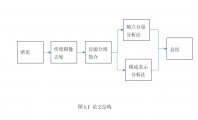基于盲源分离的图像滤噪的研究

基于盲源分离的图像滤噪的研究(任务书,开题报告,论文17600字)
摘要
盲源分离技术指的是在我们对源信号和信道统计特征一无所知的情况下,利用该技术尽可能的从观测信号恢复出源信号。盲源分离的概念和技术早在上个世纪中旬便提出,但是很长一段时间并没有受到重视,直到近十几年间,随着生产生活的需要才受到关注。如今该技术已经获得了飞速发展,并且在语音处理、雷达图像、生物工程等大展身手。
图像去噪是一个老生常谈的问题,获得一副高质量的数字图像一直是许多研究的必要基础。因此数字图像去噪技术自诞生以来就广受关注。其难点在于任何去噪方法都无法完美地分辨信号与噪声,从而无法完全去除噪声,同时对原信号也会有一定的破坏[1]。
盲源分离技术是直接将各个源信号彼此分离开。将其应用数字图像去噪,就可以把信号与噪声分离开,从而获得高质量的图像。它的原理和方法与传统图像截然不同。本文首先采用是独立分量分析(Independent Component Analysis, ICA)技术。只要把噪声也看出是一种特定的源信号,并假定它和信号独立,就可以将ICA模型应用于图像去噪中。由于ICA模型理论上存在完美逆系统,因而在仿真实验中,我们可以看到其去噪的效果十分得好。
随后本文讨论了更加复杂有难度的欠定盲源分离问题。由于其不存在逆系统,因而不能利用ICA技术。但我们由人眼的视觉特征可获得启示,并构造出独特的字典和编码方式来屏蔽噪声,从而获取源信号来完成分离去噪任务。仿真实验在信噪比和视觉效果指标上与传统去噪方法进行了比对,并分析了其有效性。
最后对本文尚未讨论和有待优化的点提出建议。
关键字:盲源分离,ICA,稀疏表示,图像去噪
Abstract
Blind source separation (BSS) is a technique to recover the source signal from the observation signal as much as possible without knowing the statistical characteristics of the source signal and the channel. The concept and technology of blind source separation have been proposed as early as the middle of last century, but for a long time it has been neglected. Until the last decade, with the production and living needs of attention. Now the technology has been developed rapidly, and in speech processing, radar imaging, biological engineering and other capabilities.
Image denoising is a commonplace problem. Obtaining a high quality digital image has been a necessary basis for many researches. Therefore, digital image denoising technology has been widely concerned since its birth. The difficulty lies in that no denoising method can perfectly distinguish the signal from the noise. Therefore, the noise cannot be completely removed and the original signal will be damaged to some extent. [来源:http://Doc163.com]
Blind source separation technology is to separate each source signal from each other directly. Digital image denoising can separate the signal from the noise and obtain high quality image. Its principle and method are quite different from traditional images. Firstly, ICA technology is adopted in this paper. ICA model can be applied to image denoising as long as noise is also identified as a specific source signal and is assumed to be independent of the signal. Since ICA model theoretically has a perfect inverse system, we can see that its denoising effect is very good in the simulation experiment.
Then the more complex and difficult problem of underdetermined blind source separation is discussed. There is no inverse system, so ICA technology can not be used. Through the visual characteristics of the human eye, a unique dictionary and coding method are constructed. The source signal is obtained by shielding the noise. Complete the task of separating and denoising. Compared with traditional denoising methods, its effectiveness is analyzed by signal to noise ratio and visual effect index
At last, some Suggestions are put forward for the points which have not been discussed and need to be optimized.
Key words: blind source separation, ICA, sparse representation, image denoising
[资料来源:https://www.doc163.com]


目录
第1章 绪论 1
1.1研究的背景与意义 1
1.2国内外发展近况 1
1.3本文研究的主要内容 2
第2章图像去噪基础 4
2.1引言 4
2.2噪声的数学模型 4
2.3噪声的种类 4
2.4传统去噪方法 5
2.5传统去噪各个结果对比 7
第3章 盲源分离原理 10
3.1数学模型 10
3.2盲源分离的模型分类 10
[资料来源:www.doc163.com]
3.3盲源分离的准则 12
3.4盲源分离算法的研究内容 12
3.5盲源分离算法的应用 13
第4章ICA盲源分离法 14
4.1目标函数的确立 14
4.2优化算法 15
4.2.1预处理 15
4.2.2算法导出 16
4.3仿真实验 19
第5章 稀疏表示盲源分离法 23
5.1稀疏表示模型在图像中的应用 23
5.2字典D的构建 24
5.3编码矩阵X的构建 24
5.4仿真实验 25
5.5本章总结 28
第6章 总结与展望 29
参考文献 31
致谢 32
[资料来源:http://Doc163.com]
